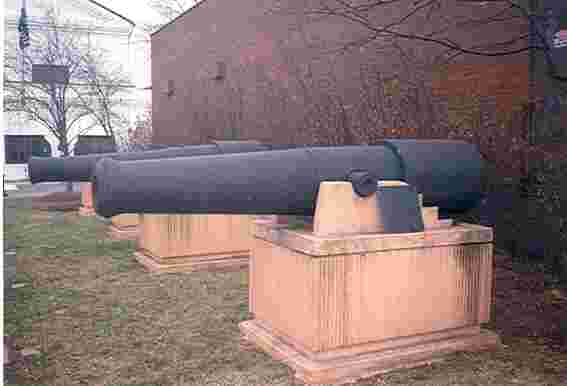Friends of Fort DeRussy, Inc.
The Official Site of Fort DeRussy, Louisiana

9-
Register No. 841
Register No. 843
According to Wayne Stark, expert on Civil War heavy ordnance, the details of these two guns’ service are lacking, but in all probability, they were made at Tredegar Iron Works in late 1856 or early 1857. They were probably rejected by the US Navy inspector at that time, and for some reason held at the foundry, perhaps in hopes that they would be accepted by a different inspector at a later date, as sometimes happened. These guns would have then been captured when the Confederacy took over Tredegar in 1861. What can be said about these guns with certainty is that neither one of them came from either the USS Indianola or USS Harriet Lane – despite Union claims that they were guns captured from those vessels. These guns could fire a 72 ½ pound shell nearly two miles. Required a crew of 17. These were the fort’s best guns.
Rifled 32-
Register No. 289. Rifled and banded by Confederacy. Currently on display at Washington Navy Yard.

Was originally positioned in the northeast corner of the fort, but was moved
to the water battery before the capture of the fort. Was the only gun in the water
battery able to be turned around and fired on the attackers. Maps indicate it was
mounted by itself in the northernmost of the 3 water batteries. Although it was a
32-
32-
Register No. 226
Register No. 227
32-
Register No. 598
32-
Fort Guns
6-
Both in fort on the hill. Both burst at fort on night of March 16, 1864.
A fragment of the breech of one of these guns shows a thicker than expected amount
of metal for a 6-
24-
These guns were in the fort on the hill at the time of the capture. According to Captain King, they were being mounted on platforms even as the Union troops were surrounding the fort. They were put aboard the steamer Blackhawk (Porter’s flagship), along with a good supply of ammunition, after capture. As there were no particular identifying marks noted, there is no record of their final disposal.
Artillery at Fort DeRussy
When Fort DeRussy was captured by Federal forces on March 14, 1864, there were ten pieces of artillery present at the fort. Six of the largest guns were in batteries on the river (the Water Batteries) and the other four guns were in the fort on the hill.
Prior to the battle, one of the 9-
“Until the water in the river has reached almost its maximum height the only really
effective guns for the defense of the river cannot be used at all. I therefore recommend
that the 9-
Water Battery Guns
The Water Battery consisted of three gun positions. Two of these positions (the outboard two) had guns mounted en barbette. The center position was a casemated battery protected by thick oak walls covered with railroad iron. The barbette batteries provided a greater field of fire, while the iron casemate provided greater protection.